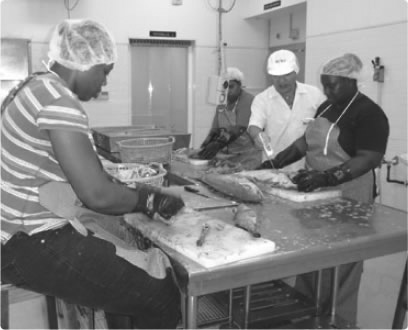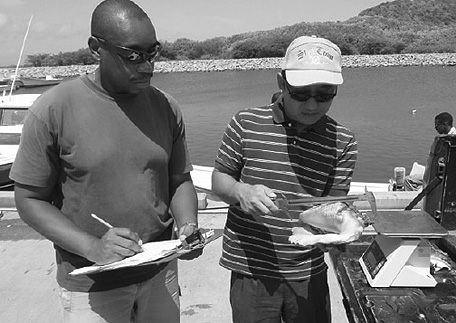Japan's Official Development Assistance White Paper 2011
Column 10
Become Friends and Share Your Goals!
—Fishing Industry Assistance in Antigua and Barbuda—

Mr. Ishida offering guidance at a marine products processing plant (Photo: Mitsuhiro Ishida)
Morning arrives at Antigua and Barbuda when swimmers take a dip at sunrise and enliven the shoreline. The "365 beaches" of the Caribbean twin-island nation attract not only the locals but also many visitors.
Tourism is the dominant industry of this country, to which foreigners flock for the beauty of the endless blue sea and sky and the white beaches lining the verdant islands. But with the threat of damage to tourist attractions posed by natural disasters such as hurricanes, the country is faced with the challenge of diversifying its industries and reducing its reliance on tourism alone.
Thanks to assistance from Japan, Antigua and Barbuda has in place harbor facilities as well as fishing ports and other marine facilities. Mitsuhiro Ishida works here as a JICA expert(*1) to help make use of these facilities and export steady volumes of abundant marine resources to neighboring countries.
Mr. Ishida, who studied food science and technology at university, has 17 years of experience in international cooperation in five countries. Having worked in Latin America, he is fluent in Spanish on top of English.
The waters of Antigua and Barbuda are rich in seafood—lobsters, groupers, emperor breams, Japanese parrotfish, and more. Exporting these marine products is expected to diversify the country's source of income. But selling produce abroad requires compliance with hygiene standards and authorization from the importing countries. Mr. Ishida works with the fisheries department staff to prepare export systems, train processing plant workers, and strengthen sales structures. One of his jobs is setting up hygiene control guidelines for the fishers' catch. This involves taking systematic records of the status of hygiene control procedures, which is very important, as without records, there is no way of tracking down the cause of trouble when it occurs. Using his fluent Spanish at a processing plant, where many employees are migrant workers from Spanish-speaking countries, Mr. Ishida has incorporated everyone's views and his own thorough understanding of the circumstances and problems into completing a set of hygiene control guidelines. He reveals the secret to making an assistance project work: "Talk it out. Become friends. That way you can share a clear sense of your goals."
At the moment, Mr. Ishida is also seeking a way to export queen conch shells, for which there are restrictions on international trade. To make clear whether some can be traded depending on size, as is the case with lobsters, he is in the process of surveying samples and preparing an index. He needs cooperation from the fishers to gather the samples, and to win their understanding he rode with them on their boats or waited for hours at port for them to return. Once, he even went for a dive himself and examined as many as 70 samples in an hour. All this is worthwhile, because the results of his survey might open the path to an important exportable marine product.
Mr. Ishida's efforts to improve the fishers' hygiene control capabilities have borne fruit, and Antigua and Barbuda is now home to the only marine products processing plant authorized to export live lobsters to EU countries. His goal is to spread this to the other plants as well and increase seafood exports from Antigua and Barbuda as a whole, so that it will be as profitable as the tourism industry. Mr. Ishida has an even greater ambition: "I hope the example of success in Antigua and Barbuda will spread across the whole of the Caribbean. I believe Antigua and Barbuda can become a model for Caribbean development."
(*1) Fishery Development Adviser (wide-area expert covering the three nations of Antigua and Barbuda, Saint Kitts and Nevis, and the Commonwealth of Dominica)

Mr. Ishida (right) measuring a conch shell (Photo: Mitsuhiro Ishida)
